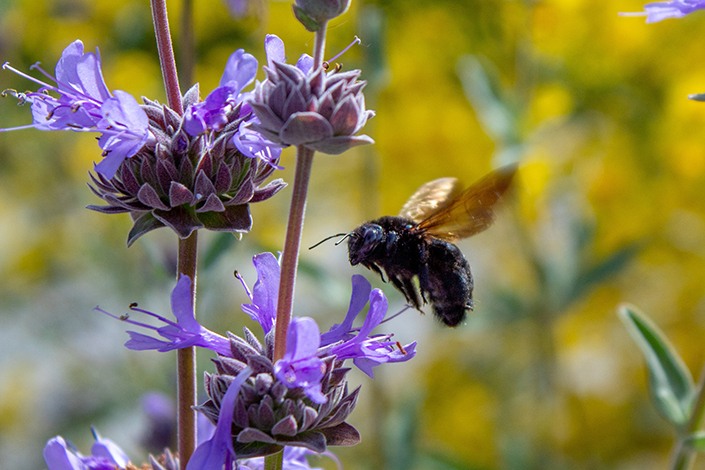Plants Pollinated by Honey Bees Produce Lower-quality Offspring
Dominant in the San Diego region, foreign honey bees visit nearly twice as many flowers as native bees
With a broad mix of plant and animal species, the San Diego region is widely regarded as a global biodiversity hotspot.
As key pollinators, bees play a foundational role in the region’s floral diversity. But not all bees have the same influence on the plants they pollinate, new research from University of California San Diego scientists has revealed. Pollination by honey bees, which are not native to the Americas, produces plant offspring of considerably inferior quality (lower fitness), than offspring resulting from native pollinators, according to the study, published in Proceedings of the Royal Society B. The study is believed to be the first to directly compare offspring fitness resulting from honey bee pollination with other floral visitors.
Previous research offered evidence that predominantly feral honey bees account for more than 90 percent of the pollinators observed visiting flowers of abundantly blooming native plant species around San Diego. In their new study, School of Biological Sciences recent graduate student Dillon Travis and Professor Joshua Kohn have shown that honey bees visit approximately twice as many flowers on an individual plant before moving to the next plant, compared with native insect visitors. However, this methodical foraging behavior appears to have a detrimental effect on reproduction in the plants they visit because most of the pollen delivered to flowers will come from the same individual plant (known as self-pollination), which can lead to lower-quality offspring.
To gain perspective on the effects of such pollination dominance and propensity to visit multiple flowers on the same plant, the researchers conducted a series of experiments that evaluated the fitness of plant offspring across factors such as seed maturation, germination, survival, growth and reproduction. Using three common plant species from native habitats in San Diego County at locations that included the University of California Natural Reserve System’s Elliott Chaparral and Dawson Los Monos Canyon Reserves, the researchers assessed a variety of conditions including natural pollination, no pollination, honey bee pollination, native bee pollination and self- and cross-hand pollination.
Four to six weeks later they collected the seeds from each scenario and compared the fitness of each. Offspring resulting from pollination by native insects (mostly various species of bees), they found, were two- to five-times more fit—characterized as likely to mature into seed, germinate, grow and reproduce—than those resulting from pollination by honey bees. This seems to be the result of higher levels of self-pollen delivered by honey bees, since offspring resulting from hand pollination using pollen from the same individual plant were two- to 10-times less fit than offspring produced using pollen from a different plant of the same species.
“While honey bees are perceived as beautiful mutualists that are helping plants with reproduction, it turns out they may not be as good for plants as many native pollinators. We have found that they deliver lower-quality pollen than do native pollinators.”
— Professor Joshua Kohn
 A California carpenter bee visits Cleveland sage. Credit: Dillon Travis
A California carpenter bee visits Cleveland sage. Credit: Dillon Travis
“While honey bees are perceived as beautiful mutualists that are helping plants with reproduction, it turns out they may not be as good for plants as many native pollinators,” said Kohn, a professor in the Department of Ecology, Behavior and Evolution. “We have found that they deliver lower-quality pollen than do native pollinators.”
In a related study (Travis and Kohn, in press), honey bees were shown to visit more flowers per plant than average among other pollinators across 44 different plant species, which included both crop and non-crop plants. So the foraging behavior of honey bees may regularly deliver more self-pollen, resulting in lower quality offspring.
Honey bees are the world’s most frequent floral visitor, accounting for some 13 percent of all global floral visits to native vegetation. They are native to Europe, Western Asia and Africa and were first brought to the Americas in the 17th century. San Diego is regarded as “honey bee heaven” with a higher frequency of floral visits by honey bees than nearly anywhere else in the world. The area also features more than 650 species of native bees and other pollinating insect species that interact with at least 2,400 types of plants, more than any other county in the United States.
“If honey bees generally lower seed fitness of native plants, it could make the native plant community more susceptible to invasion from introduced plant species that do not require insect pollination…” the researchers note in their paper. These introduced plants are often grasses and other invasives that help spread wildfires in these ecosystems.
“People see honey bees as providing a valuable service, which is pollination, but there’s a decent amount of evidence to show that they’re competing with native insects for resources like pollen and nectar,” said Travis, who indicated that honey bees are also known to have viruses that can be transferred to native bees. “Many conservation efforts are focused on saving the honey bee, but they are not in any danger of going extinct. In fact, their numbers have been increasing. The organisms that do need our help are the native plants and bees.”
The study was funded by the Sea and Sage Audubon Society, the Messier Family Fund and a UC Multicampus Research Program grant.
Publication: Keng-Lou James Hung, et al., The worldwide importance of honey bees as pollinators in natural habitats, The Royal Society Publishing (2023) DOI: 10.1098/rspb.2017.2140
Original Story Source: UC San Diego

 Alerts Sign-up
Alerts Sign-up